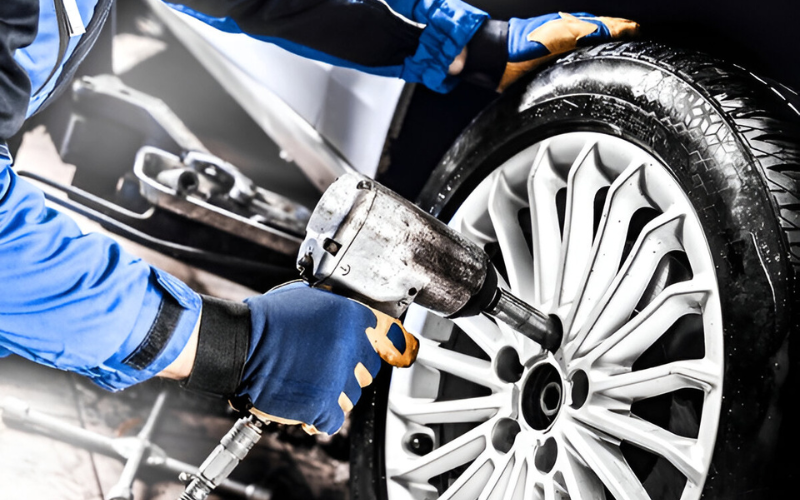Introduction
If you’re thinking about buying new wheels, replacing your current ones, or upgrading to an aftermarket set, knowing your wheel stud pattern is essential. But what exactly is a wheel stud pattern—and how do you measure it correctly?
Whether you’re a beginner working on your first car project or just curious about your vehicle’s wheel setup, this guide will help you understand what the stud pattern is, how it affects wheel fitment, and how to measure it properly without getting overwhelmed.
Understanding What a Wheel Stud Pattern Is
Before learning how to measure it, it’s important to understand what the wheel stud pattern (also known as a bolt pattern) actually refers to. It’s the specific arrangement of the bolts or lugs on your vehicle’s wheel hub. This pattern ensures that wheels line up perfectly with the hub, providing a secure and safe fit.
The stud pattern is typically expressed in a two-number format. For example:
- 5×114.3 means 5 lugs evenly spaced around a circle with a 114.3 mm diameter.
- 4×100 means 4 lugs on a 100 mm circle.
The first number refers to how many lug nuts or bolts the wheel has, and the second number tells you the diameter of the invisible circle that connects the centers of each lug.
Why is this important? Because not all wheels fit all vehicles. Even if the wheel size or offset matches, an incorrect stud pattern will prevent the wheel from mounting properly. This can cause safety issues or damage over time. That’s why measuring your stud pattern accurately matters.
Tools You’ll Need to Measure a Stud Pattern
To measure a wheel stud pattern, you don’t need expensive or complicated equipment. A few basic tools can get the job done quickly and accurately:
- Tape measure or ruler: Make sure it measures in millimeters for better precision.
- Calipers (optional): Great for more accurate measurements.
- Marker or chalk: Helpful for marking stud centers or visualizing the circle.
- Notepad or phone: You’ll want to record your measurements for reference.
If you’re working in tight areas or trying to get exact specs for aftermarket wheels, a set of digital calipers can really help fine-tune the numbers. But for most DIY situations, a tape measure works just fine.
Step-by-Step Method to Measure a 4-Lug Pattern
Measuring a 4-lug wheel pattern is one of the simpler processes since it has an even number of studs. Here’s how you do it:
Start by identifying the center of one lug and measure straight across to the center of the lug directly opposite it. This gives you the diameter of the circle the lugs are positioned on.
Let’s say you measure 100 mm across. That means your stud pattern is 4×100. Simple as that.
Even-numbered lug patterns are always measured directly across. Just make sure you’re going center-to-center, not edge-to-edge, to avoid miscalculating the diameter.
How to Measure a 5-Lug Wheel Stud Pattern
Measuring a 5-lug stud pattern is slightly more complex because it’s an odd number. You can’t measure straight across like with 4-lug setups. Instead, you’ll use what’s called the circle method.
The Circle Method Explained
To estimate the diameter of a 5-lug pattern, measure from the center of one lug to the outer edge of the lug directly across from it. Since there’s no directly opposite lug, you’re using geometry to estimate the circle’s size.
Here’s a quick example: If the distance from the center of one lug to the outer edge of another lug (not next to it) is around 114.3 mm, the pattern is 5×114.3.
It might not be as precise as using digital tools, but this method works well for general measurements and visual matching.
Dealing with Non-Symmetrical Layouts
Some vehicles have non-standard or staggered patterns that aren’t perfectly symmetrical. In such cases, it’s best to use a wheel bolt pattern gauge or take measurements multiple times to verify accuracy.
Mistakes to Avoid When Measuring Wheel Stud Patterns
Even though measuring a wheel stud pattern is fairly simple, people often make common mistakes that lead to wrong results. Here are a few to avoid:
Using the wrong reference points: Always measure from the center of one stud to another—not the edge. Measuring incorrectly can lead to mismatched wheels.
Mixing up units: Some wheels list patterns in millimeters, others in inches. Always convert if necessary to make sure you’re comparing the correct values.
Guessing instead of measuring: Visual guesses can be misleading. Even if two patterns look close, they might differ by just enough to cause issues.
These mistakes might seem small, but even a slight error can result in wheels that won’t fit, wobble while driving, or damage your suspension system.
When to Check Stud Pattern Before Buying Wheels
Knowing how to measure your wheel stud pattern is most helpful when you’re planning to:
- Buy aftermarket wheels or rims
- Replace damaged wheels with used ones
- Upgrade your car’s appearance or performance setup
- Switch between seasonal tires on different wheel sets
In each of these cases, checking the stud pattern ensures you’re buying wheels that will fit your car properly. Even if you’re shopping online, many retailers list stud patterns alongside other specifications. Cross-check those numbers with what you’ve measured to be safe.
You can also find your vehicle’s factory specifications in the owner’s manual, inside the driver-side door jamb, or through manufacturer websites. But if the wheels have been swapped in the past, it’s still smart to measure.
Conclusion
Understanding how to measure a wheel stud pattern doesn’t require professional tools or expert skills. With a simple tape measure and some patience, you can determine the exact stud layout for your vehicle and avoid costly fitment issues.
Whether you’re replacing old wheels, exploring upgrades, or buying secondhand rims, taking a few minutes to measure accurately will save you time and money. Use this guide as your go-to reference, and you’ll be ready to shop for wheels with confidence.
FAQ
Q1: Can I measure wheel stud pattern without removing the wheel?
Yes, you can. Use a flexible tape measure and work around the exposed studs or bolts. However, removing the wheel often gives you more accurate and easier access.
Q2: Is stud pattern the same as bolt pattern?
Yes, both terms are often used interchangeably. “Stud pattern” is more common in some regions, while “bolt pattern” might be preferred in others.
Q3: What does 5×114.3 mean exactly?
It means the wheel has 5 lug bolts spaced evenly around an invisible 114.3 mm diameter circle. This format helps identify compatible wheels.
Q4: Do all cars use the same stud pattern?
No, stud patterns vary widely between makes, models, and even years. Always check your specific vehicle’s specs before purchasing new wheels.

